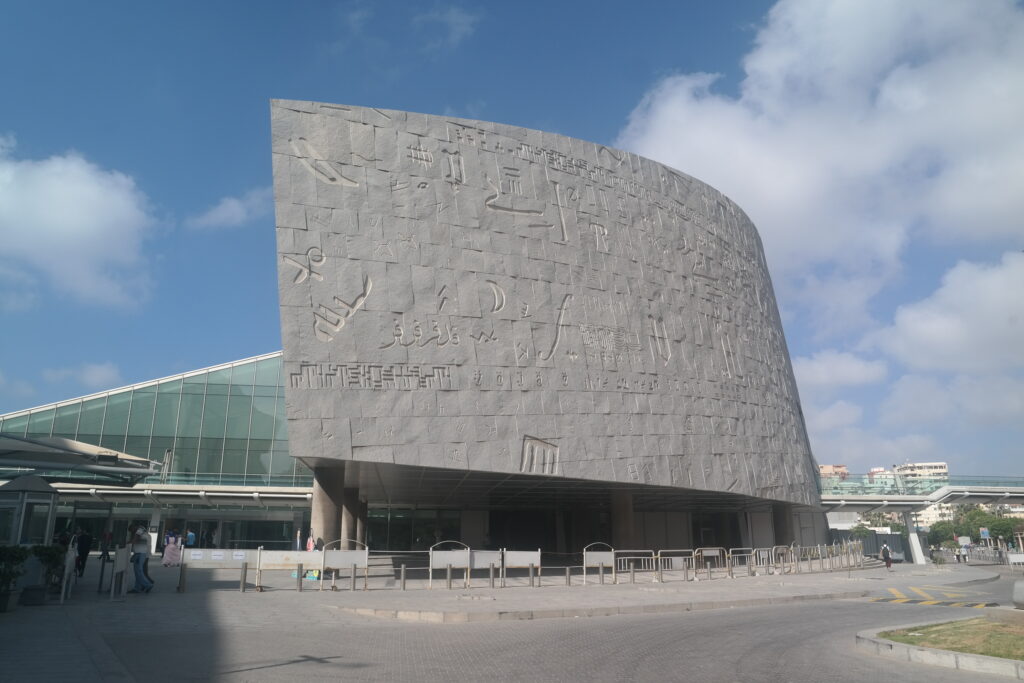Bibliothèque d'Alexandrie :

L'une des plus grandes et des plus célèbres bibliothèques de l'Antiquité et des temps modernes
Dans l'Antiquité, Alexandrie était célèbre pour son phare, le tombeau d'Alexandre le Grand et la Bibliothèque d'Alexandrie, probablement construite au IIIe siècle avant J.-C. et devenue un centre d'éducation, de science et de culture. Elle aurait contenu entre 400 000 et 700 000 manuscrits, volumes ou rouleaux de papyrus de divers domaines. Parmi ceux-ci figuraient des textes écrits en hiéroglyphes, en cunéiforme antique, en écriture grecque, ainsi que des œuvres de philosophes et de scientifiques antiques tels qu'Archimède, Euclide, Homère et Aristote.
La bibliothèque fut incendiée en 48 av. J.-C. pendant le règne de Jules César au milieu d'une guerre civile et fut complètement détruite entre 270 et 275 apr. J.-C.
The modern library stands at the same location as the ancient one. It was opened in 2002 with a unique design and is a major attraction for tourism and culture in Egypt. The building is designed to resemble the sun rising out of the water’s surface, featuring a slanting cylindrical shape with a massive circular wall inscribed with approximately 6,300 letters, words, and symbols from various ancient and modern world civilizations.
Les salles de la bibliothèque peuvent accueillir environ 8 millions de livres, répartis sur 9 niveaux (soit environ 10 étages) et environ 90 colonnes. Grâce à sa conception unique, la lumière naturelle pénètre indirectement dans les salles de lecture, offrant un éclairage agréable.
La bibliothèque comprend six bibliothèques spécialisées axées sur les arts et le multimédia, dont la bibliothèque Taha Hussein pour les malvoyants, une bibliothèque pour enfants, la bibliothèque et les archives Al-Nashq, une section de livres rares et des centres d'études tels que la calligraphie, les manuscrits, la civilisation et les études islamiques, et le Centre d'études hellénistiques d'Alexandrie.
De plus, la bibliothèque comprend quatre musées :
-
Le Musée des Antiquités, l'un des rares musées au monde à exposer des objets trouvés sur le site de la bibliothèque,
-
Un musée de manuscrits,
-
Un musée Sadate,
-
A Museum of the History of Science.
Il y a également un centre de planétarium scientifique, une salle de recherche sur l'éducation scientifique pour les enfants, un centre d'art avec environ 17 expositions permanentes et un centre de conférences.
La bibliothèque d'Alexandrie est aujourd'hui un symbole de connaissance, de culture et de recherche scientifique, reliant le riche héritage du monde antique à la vie académique et culturelle moderne.
Le Bibliothèque d'Alexandrie in Egypt is one of the most iconic symbols of human knowledge and ancient civilization. Originally established in the 3rd century BCE, it was once the largest and most significant library of the ancient world. In 2025, the modern Bibliotheca Alexandrina continues this legacy by offering a space that celebrates education, science, culture, and global dialogue.
Table des matières
ToggleA Legacy of Knowledge
The ancient Bibliothèque d'Alexandrie was founded during the reign of Ptolemy I or Ptolemy II and aimed to collect every written work in existence. Scholars from around the Mediterranean came to study philosophy, astronomy, mathematics, and medicine. Although the original library was lost in antiquity—likely due to a series of fires and political conflicts—its spirit lives on through the modern reconstruction.
Le modern Library of Alexandria, opened in 2002, revives the vision of a universal center for learning. It is home to millions of books, digital resources, rare manuscripts, and art exhibitions. As of 2025, it continues to evolve with new technologies and global partnerships.
Iconic Architecture
The architecture of the Bibliotheca Alexandrina is as breathtaking as its mission. Designed by the Norwegian firm Snøhetta, the library resembles a massive sun disc rising from the Earth. Its granite outer wall is engraved with characters from over 120 scripts, symbolizing global knowledge and diversity.
Inside, the building spans eleven levels with open reading spaces bathed in natural light. In 2025, it remains one of Egypt’s most visited architectural landmarks and a hub for educational tourism in Alexandria.
Why Visit in 2025?
With Egypt experiencing a surge in cultural tourism, 2025 is the perfect year to visit the Library of Alexandria. The library regularly hosts international exhibitions, academic conferences, and public lectures that attract scholars and travelers alike.
Whether you’re a history enthusiast, architecture lover, or curious traveler, a visit to the Library of Alexandria offers a chance to connect with one of humanity’s oldest intellectual legacies.
Conclusion
Le Library of Alexandria in 2025 is more than just a building—it is a bridge between the ancient and modern worlds. Its rich history, inspiring architecture, and continued educational mission make it a must-visit destination for anyone exploring Egypt’s cultural treasures.
